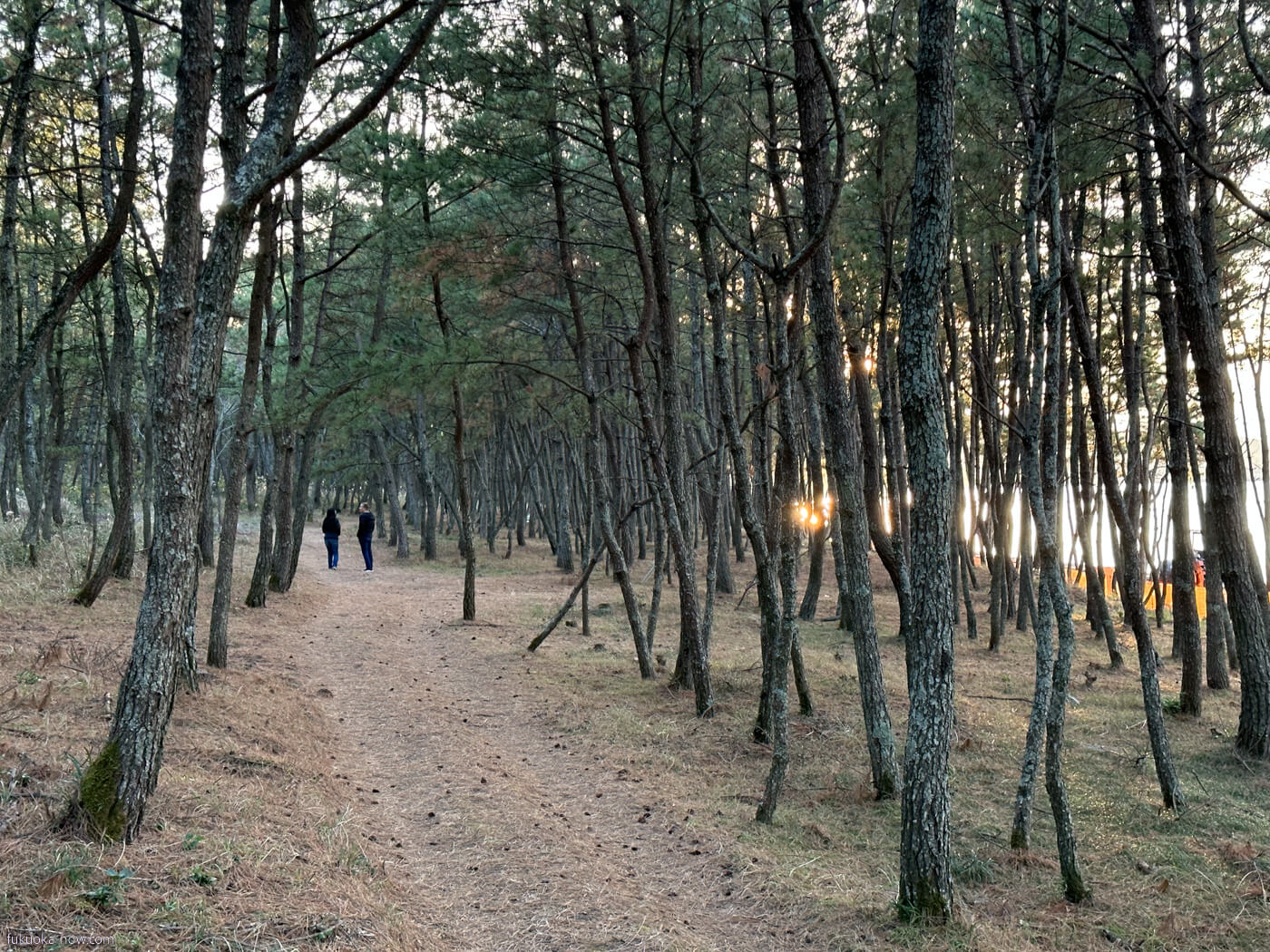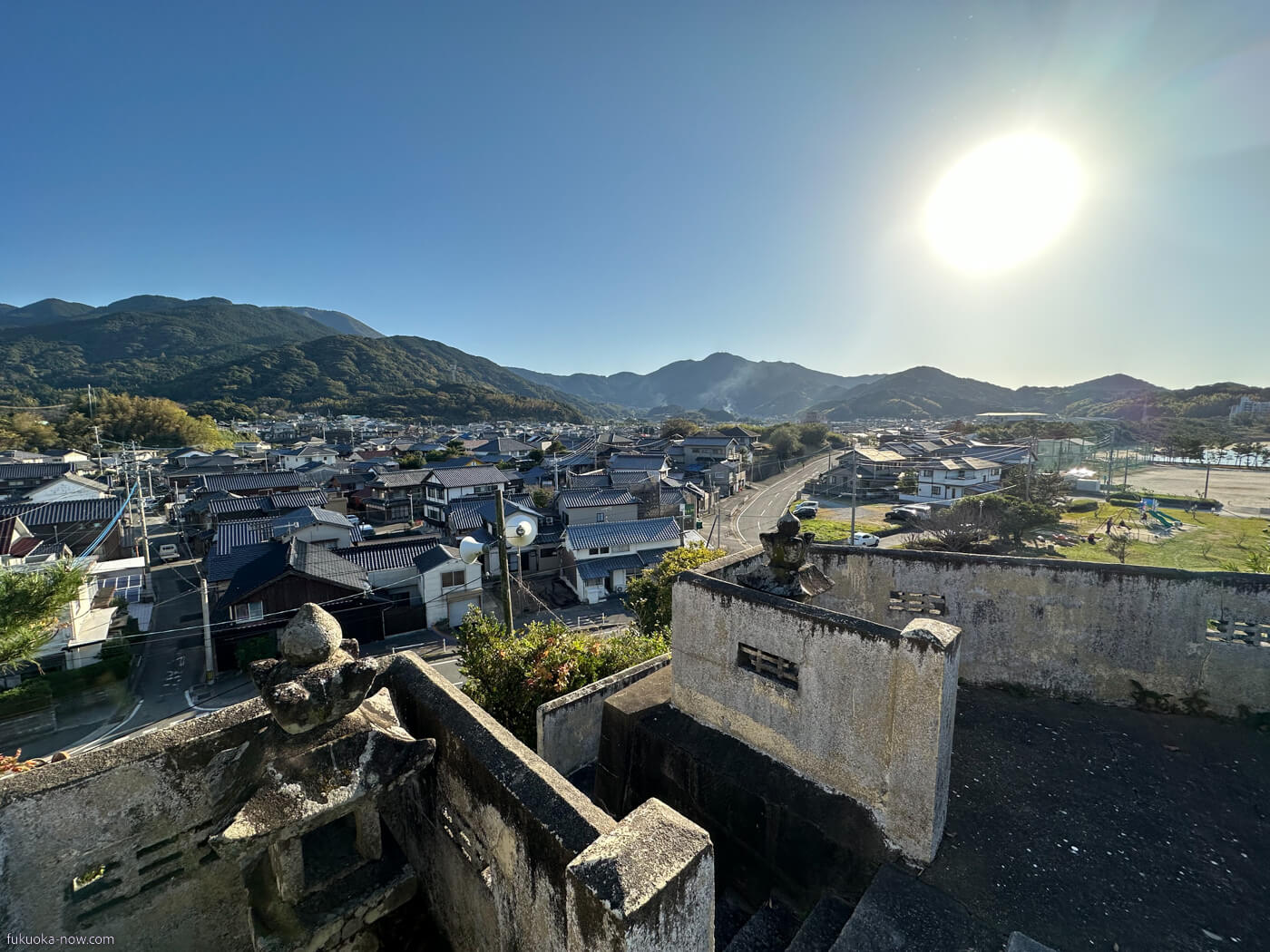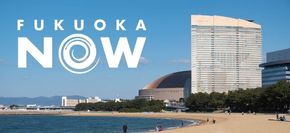While it is known for its green-blue sea and silky sandy beaches, Itoshima City is also home to peaceful satoyama—border zones where foothills meet arable land—with expansive fields where rice and many fruits and vegetables are grown. The city is now attracting attention from throughout Japan and overseas as an area where delicious produce is grown and as a day-trip destination close to urban Fukuoka.

In this installment, entitled “Itoshima on Foot,” we present the first of a series of special features that aim to help visitors enjoy Itoshima and its abundant nature. First, let’s look at our Nijo-Fukuyoshi walking course accessible from the JR Chikuhi Line, which is directly connected to the Fukuoka City Subway. This is a course that you can enjoy even if you don’t have a car, or more precisely, because you don’t have a car!

The course takes about three hours, but you can stretch it out over the course of a day by taking side trips and having meals as you go. So, what are you waiting for? Let’s get out of the city and go walking in Itoshima!
Start Point: Fukuyoshi Station, JR Chikuhi Line
• Nijo-Yoshii Itoshima City, Fukuoka
Trains that connect Fukuyoshi to Tenjin and Hakata run about twice an hour and take about one hour from Hakata Station. Fare: ¥870 one way. Fukuyoshi Station is an unmanned station. Although there are toilets, there are no coin-operated lockers available.

First, take the north exit of Fukuyoshi Station and walk east on Route 202. After passing the “Fukuyoshi Sta.” intersection and the Family Mart (convenience store), you will see a small shop with a triangular roof on Route 202.

Faimiru
• 4022-7 Nijo-Yoshii, Itoshima City, Fukuoka
This is Faimiru, where the owner, a woman originally from Miyako Island in Okinawa, bakes fresh breads and cakes. In the Miyako Island dialect, faimiru means “eat up.” The fluffy bread she bakes first thing in the morning sells out quickly.
Directly in front of you, you will see the “Fukuyoshi Post Office” intersection. Cross the railroad tracks and walk toward the mountains.

This point is about a 15-minute walk from JR Fukuyoshi Station. Here you will see the face of a giant 12-meter-high Buddha at the foot of the mountain.

Hakuryusan Myogenji Temple
• 5753 Nijo-Fukui, Itoshima City, Fukuoka
• https://temple.nichiren.or.jp/7011091-myougenji/
Stop at Myogenji Temple to pay your respects to the giant Buddha, then continue walking uphill. This route exposes you to what can be called “everyday Itoshima.” As you walk, you can enjoy the scenery overlooking the sea, bamboo forests and mandarin citrus groves.




Near the end of the forest road, you will come to Hakusan Shrine, which is known for its kagura (folk) dance. (there are also restrooms.)

Fukui Hakusan Shrine
• 4909 Nijo-Fukui, Itoshima City, Fukuoka
• https://hakusanjinjya.amebaownd.com/
Steeped in history, Hakusan Shrine was originally built in or before 1141, and people come here to pray for match-making. Every May, Fukui Kagura, an intangible cultural asset of Itoshima City, is performed at the shrine’s spring festival. The present shrine building, with its various carvings, was built in 1856.

By this time, you may start to get hungry and thirsty. Look for the small farm-direct shop with a yellow roof. This is Fuku Fuku no Sato. It sells a variety of rare, high-quality food products, and there is also a restaurant called Fuku Fuku next door.


Fuku Fuku no Sato
• 6333 Nijo-Fukui, Itoshima City, Fukuoka
• https://fukufuku-sato.com/
• Open: 9:00~17:00
• Closed: Jan. 1~5, Aug. 14~16
The shop sells fruits and veggies grown by local nearby farmers, fresh fish landed from the Genkai Sea, Itoshima beef and Iki-san pork handmade bento lunches and more. There are also original products like Haruka, 100% juice made from Itoshima-grown citrus fruits, and Haruka soft-serve ice cream. In the spring, the field in front of the shop turns yellow when the rapeseed blossoms come into bloom.

The next leg of the walk takes you into the satoyama area, where you stroll leisurely along a road surrounded by farmland.


If you stay on the road, you will soon find yourself near Dainyu Station on the JR Chikuhi Line. This is about the halfway point of the walking course. If you prefer a shorter course, you can take a look at the Dainyu fishing port before heading back to Tenjin/Hakata from Dainyu Station.

After walking through the fields, crossing the railroad tracks and entering the Dainyu area, you will see a sign for Western Marin.

Western Marin
• 2503-10 Nijo-Fukui, Itoshima City, Fukuoka
• https://westernmarin.com/food-2/
• 092-326-5988
Here you can grill seafood, meat and other goodies by yourself over a charcoal brazier. (Reservations are required.) In the summer, SUP and kayak rentals are also available.

Walk away from Western Marine, and you’ll see Dainyu Fishing Port.

Dainyu Fishing Port affords you with breathtaking ocean views. The large pier is a popular fishing spot, but the calm, clear sea with Mt. Nijodake in the background is typical of Itoshima’s scenery. It’s really worth the short walk out.

From the beautiful Dainyu area, with its ocean views, sandy beaches, mountains and fishing port, walk through the pine grove along the ocean.

This area used to be called Shiromikuchi (lit., “white mouth”) because people who left Karatsu early in the morning on horseback would arrive here when the sky in the east was turning white. Once you see Jizo shrine, you can find your way back to Route 202. A leisurely stroll though this quiet pine grove might be one of the highlights of this entire course – take your time!


We recommend enjoying the goodies (bento, sweets, drinks or fruit) that you bought at Fuku Fuku no Sato along the coast before walking in the forest. Please be sure not to leave any garbage behind!
After exiting the pine forest area, return to the main road and walk towards the west for a few minutes. Continue west on the back street for a few minutes until you see a dark blue house on the right.

Leatherwork and New Zealand goods store BLESS
• 5450 Nijo-Fukui, Itoshima City, Fukuoka
• https://blessleather.com/
The Bless leather workshop is run by a very friendly Japanese couple who once lived in New Zealand. They also hold leatherworking workshops where you can make charms, coin purses and other items that you can engrave with names and/or dates. (Reservations are recommended.)


And last but not least, oyster huts! Fukuyoshi is the place to go in Itoshima for oyster huts that are easily accessible by train – the port is just a few minutes on foot from the station.

Here you can enjoy grilled oysters in the classic style. First, buy oysters and other seafood from the vendors, then grab a table inside a plastic greenhouse and start grilling.


Oyster Huts at Fukuyoshi Fishing Port (4 huts)
• Nijo-Fukui, Itoshima City, Fukuoka
• Open: 10:00〜17:00
• Winter only (Late Oct.~Mid-Mar.)
• https://www.fukuoka-now.com/en/itoshima-kakigoya-oyster-hut-guide/#d

At the end of Fukuyoshi Fishing Port, at the bottom of the stairs of Asahimori Shrine next to Fukuyoshi Shiosai Park, is a stone that tests one’s strength. Fukuyoshi Port, once a busy shipping port, was a fisherman’s town. There remain three large, medium, and small stones where the men of the sea who gathered there tested their strength.

Grilled oysters are a winter tradition in Itoshima, so you can’t go wrong with a meal at an oyster hut, but the seafood bowls and bento lunches from farm-direct shops are also delicious. In fact, there are so many delicious foods in Itoshima that you are better off planning what you want to eat before you get there.

Itoshima Pork Shop BuuBu
• 3567-8 Nijo-Yoshii, Itoshima City, Fukuoka
• https://buubu-butchershopdeli.business.site/
There are also made-to-order Itoshima pork cutlet sandwiches and croquettes that you can take out or eat at the tables inside the shop. You can also buy pork directly from the farmers who raise the pigs.

Behind Fukuyoshi Station, there is a café and direct sales shop in a renovated warehouse run by Wakamatsu Farm.

You can also buy some of their original homemade menu items, like the veggie pizza made with lots of locally sourced vegetables and sweets made from olives, to take home.

Rita Cafe
• 3745-8 Nijo-Yoshii, Itoshima City, Fukuoka
• https://itoshima-olive.com/
Rita Cafe sells processed goods made from its pesticide-free, organically fertilized fruits, vegetables and grains. The organic lifestyle of the owner and his wife, who moved to Itoshima in search of the lifestyle they desired, is also attracting attention.
Itosima Now Report >> https://itoshima-now.com/en/food/wakamatsu-farm-market-cafe-rita/
This course can take anywhere from three to six hours. If you take a more leisurely pace and make little side trips, the course can last up to five or six hours. This is the first installment of Enjoy Itoshima on Foot in which we guide you to lesser known parts of Itoshima. Feel free to share your comments and suggestions with us at contact (@) itoshima-now.com
Other day trip by Itoshima Now
• Itoshima on Foot: Itoshima on Foot: Enjoy the ocean, mountains, farmland and beaches at a leisurely pace (this page)
• Itoshima by Ebike: Itoshima by E-Bike! Country Roads, Seaside Roads, and Amazing Views
• Itoshima by Car: Itoshima Revealed: Exploring Local Artisans And Stunning Landscapes By Car








